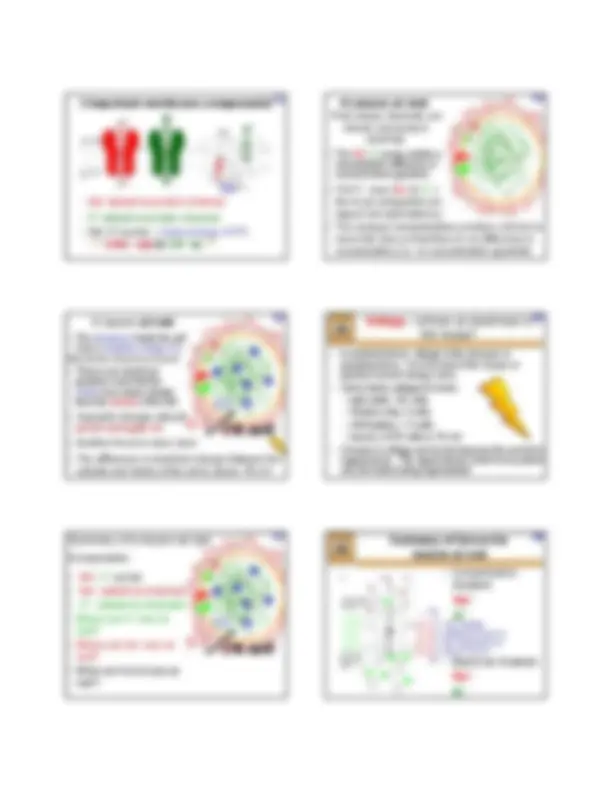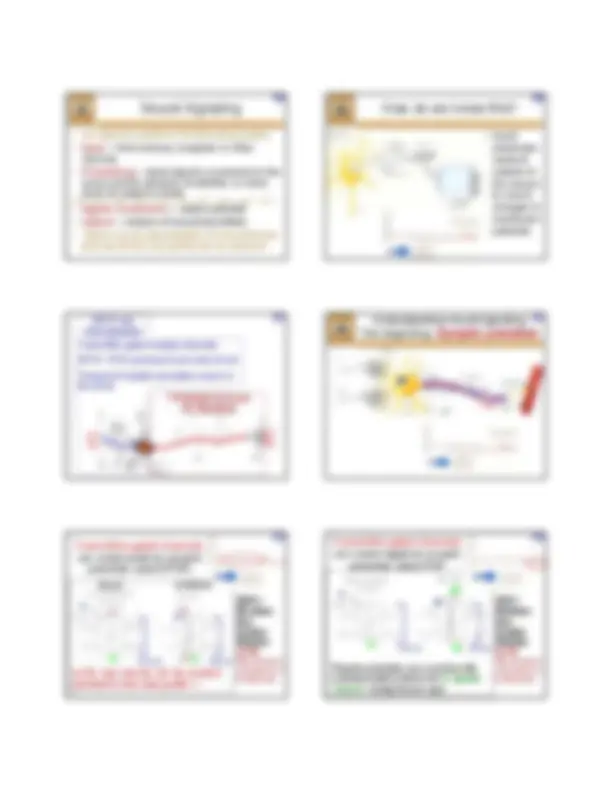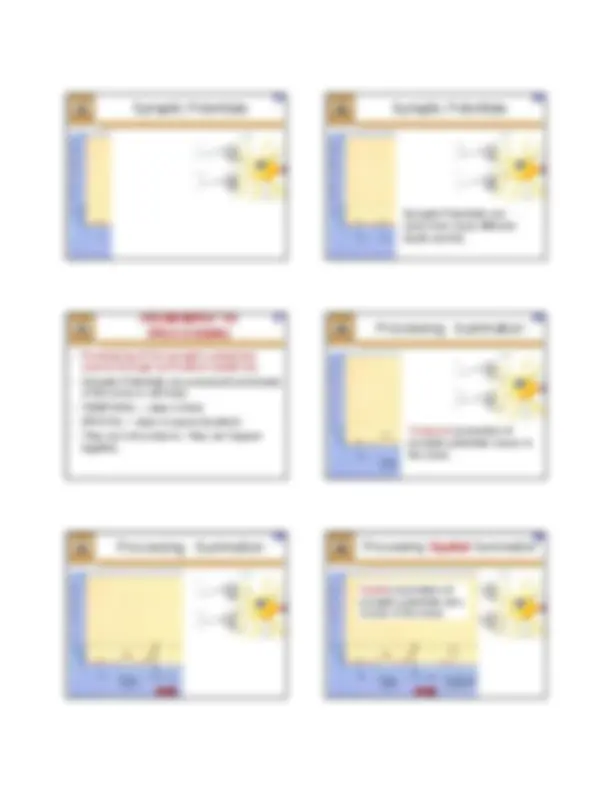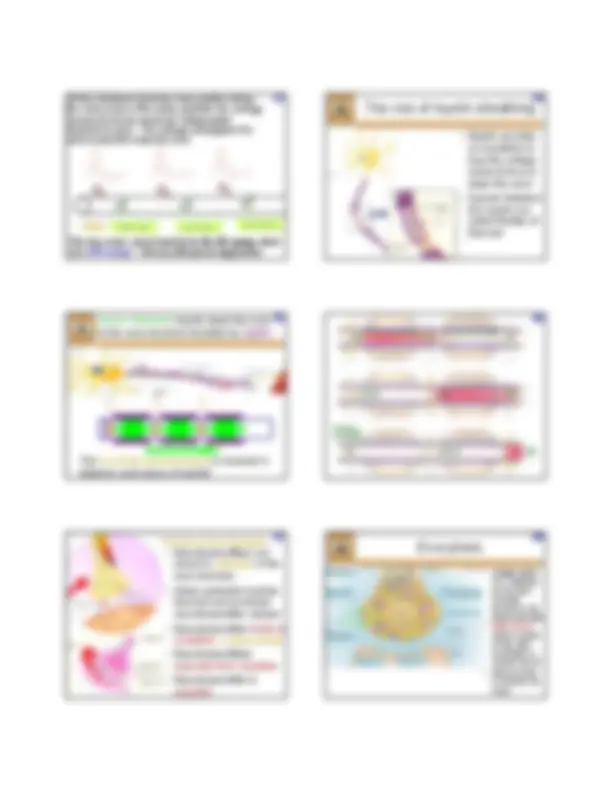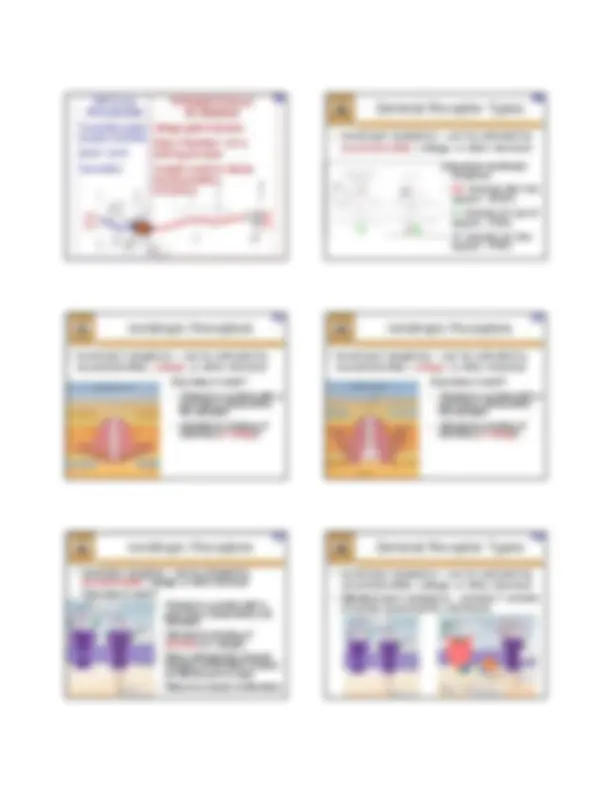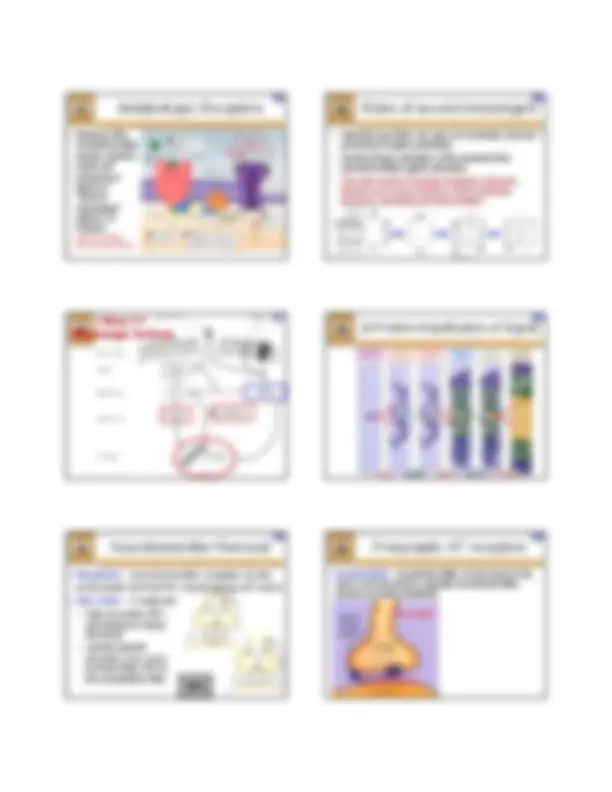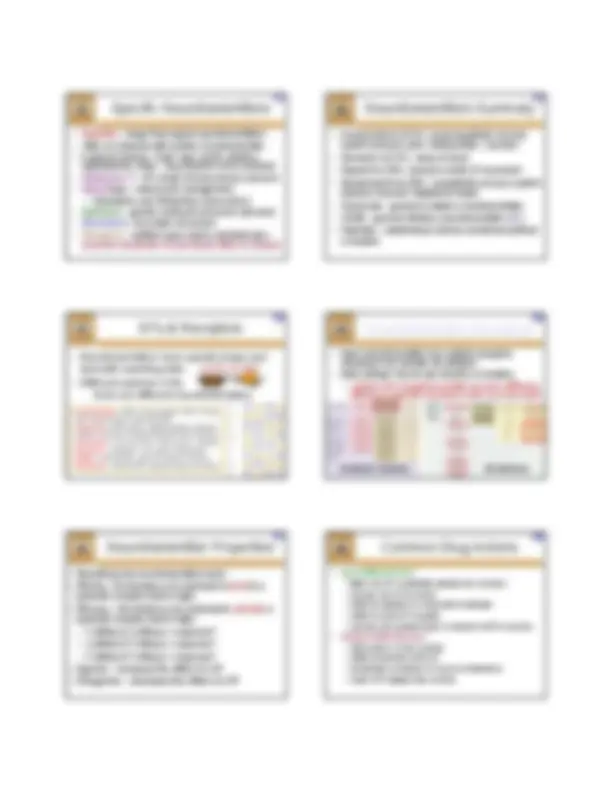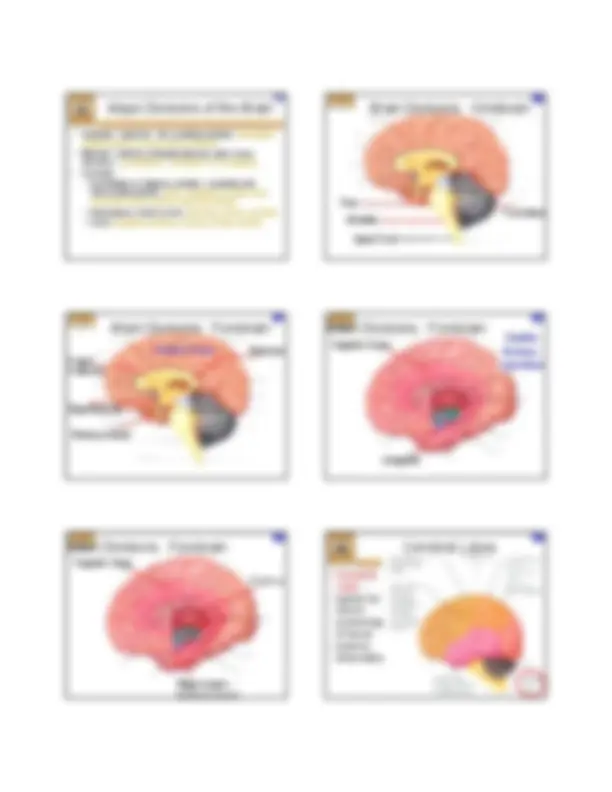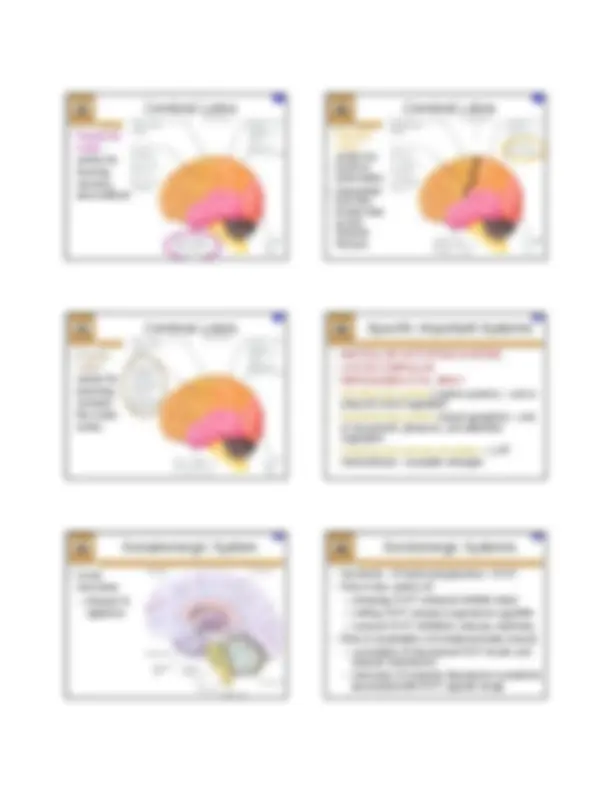Download Neural Signaling - Psychopharmacology - Lecture Slides | PSY 351 and more Study notes Pharmacology in PDF only on Docsity!
Neural Signaling
- Electrical signals carry information along a neuron
- Longer distances need faster signal
- SYNAPTIC POTENTIALS: Used to process input
- ACTION POTENTIALS: Used to transmit output signal along axon – ALL OR NONE PRINCIPAL
- Chemical signals transmit info between neurons
- Shorter distance so signal can be slower
but more selective
- Neurotransmitters selectively activate
targets
Structure of a Neuron
- Dendrites - input • Soma - cell body
- Axon hillock - start of the axon
- Axon - output
- Myelin Sheath – glia cells provide insulation
- Axon Terminals - release of neurotransmitters
- Synapse - junction between neuron & target
(motor neuron)
Motor Neuron
Sensory Neuron
Specialization of common components
depending on the role of a neuron
There are many different types of neurons but
all neurons share common structures & signaling
properties ( chemical, electrical, summation )
You should be able to define the general
function of a neuron based on the structure
of the neuron!
Neural Connections
Receptor Neuron Neuron Neuron
Neuron
Muscle
Neuron Blood Vessel
receptor or
another
neuron
neuron,
non-neural
tissue, or
blood vessel
neurotransmitter in blood called a hormone
Cellular Components
Cellular^9 Components
- Each neuron is its own mini-factory
- Nucleus – contains blueprints for all activities
- Mitochondrion – produces ATP (powerhouse)
- Ribosomes – make new proteins / chemicals
- Endoplasmic Reticulum – storage & transport, can store calcium (Ca2+^ ) neurotransmitter release
- Golgi Complex – vesicle packaging of NT
- Microtubules – transport highways (axons)
- Lysosomes – clean-up enzymes
From the bag to the cell
Cytoplasm
Cellular Components
Extracellular fluid
- Cell Membrane
- Extracellular fluid -
fluid surrounding the
cell
Components
inside the cell
(intracellular fluid)
Components of the cell membrane
- Cell membrane (plasma membrane) - two layers of fat molecules
- Cytoplasm - fluid on the intracellular side of
the cell membrane (intracellular fluid)
- Extracellular fluid - fluid on the extracellular
side of the cell membrane (outside of the cell)
extracellular
intracellular
a hydrophilic head
and hydrophobic
tails
More on the cell membrane of neurons
- Spanning the cell membrane are proteins that form channels
- Protein channels can open & close to allow selective crossing of the membrane by ions
extracellular
intracellular
- Special pumps in the membrane use energy
to pump Na+^ ions out of the cell and K+^ ions
into the cell. This becomes important later.
- Ca2+^ pumps also become important later on.
Neural Signaling
- All neurons perform the following tasks:
- Input – from sensory receptors or other
neurons
- Processing – input signal is processed in the
soma and the decision of whether or not to
send an output is made
- Signal Conduction – action potential
- Output – release of neurotransmitters
- There may be specialization of one particular
task but all four are performed by neurons!
How do we know this?
electrodes
inside &
outside of
the neuron
to record
changes in
membrane
potential
TRANSMISSION and NT RELEASE
INPUT and^21
PROCESSING
Transmitter-gated receptor channels EPSP / IPSP produced by ion entry & exit
Temporal & Spatial summation occurs in the soma
Understanding neural signaling^22
The beginning: Synaptic potentials
Transmitter-gated channels
can create positive synaptic
potentials called EPSPs
As Na +^ ions enter the cell - the electrical potential becomes more positive +
-70 mV
At rest
-65 mV
Activated
EPSP = E xcitatory P ost- S ynaptic P otential NOTE: The channel is only open for a brief period.
-70 mV -75 mV
Negative potentials can occur if specific neurotransmitters bind to the K+^ specific channels causing them to open
Transmitter-gated channels
can create negative synaptic
potentials called IPSP
IPSP =
I nhibitory P ost- S ynaptic P otential NOTE: The channel is only open for a brief period.
Synaptic Potentials Synaptic Potentials
Synaptic Potentials can
come from many different
inputs (axons)
FROM INPUT TO^27 PROCESSING
- Processing of the synaptic potentials
occurs through summation (additive):
- Synaptic Potentials are processed (summate)
in the soma or cell body.
- TEMPORAL – close in time
- SPATIAL – close in space (location)
- They are not exclusive - they can happen
together.
Processing: Summation
Temporal summation of
synaptic potentials occurs in
the soma
Processing: Summation
Processing: Spatial Summation
Spatial summation of
synaptic potentials also
occurs in the soma
Remember these forces
e c e c
- With Na+^ channels open
- Na+^ is forcefully driven into the cell increasing the membrane potential to +
- When the membrane reaches -40 mV voltage- gated K+^ channels open and allow K+^ to exit the cell.
Opening and closing of the Na+^ channels and
the K+^ channels create the action potential.
During an action potential the membrane changes from:
-70mV up to +30 mV then back down to under -70 mV
before returning to the resting potential of -70 mV
It is the timing of opening and closing of the
Na+^ channels and the K+^ channels that makes
the membrane voltage go up and down.
Rate of entry for Na +^ ions
Rate of exit for K+^ ions
0 1 2 3 4 msec
+30 mV
-70 mV
- Rising Phase: Na +^ Entry
- Falling Phase: K+^ Exit
- The Na+/K+ pump restores ion concentrations
Visualizing
ionic transport
during the
action
potential.
0 1 2 3 4 msec
+30 mV
-70 mV
- Rising Phase: Na +^ Entry
- Falling Phase: K+^ Exit
- The Na+/K+ pump restores ion concentrations
Visualizing
ionic transport
during the
action
potential.
Execution by lethal injection: high extracelluar K+^ concentration
0 1 2 3 4 msec
+30 mV
-70 mV
- Rising Phase: Na +^ Entry
- Falling Phase: K+^ Exit
- The Na+/K+ pump restores ion concentrations
Visualizing
ionic transport
during the
action
potential.
Execution by lethal injection: high extracelluar K+^ concentration stops all neural activity
As the membrane becomes more positive during the rising phase of the action potential, the voltage causes previously unopened voltage-gated channels to open. The voltage propagates the action potential down the axon.
This also creates a lot of work for the Na+/K+ pump , which uses ATP energy! - Not very efficient for long neurons.
voltage (^) + + + + + + + + + ++ + + + + + + + + ++ + + + +
The role of myelin sheathing
an insulation to
trap the voltage
inside & force it
down the axon
the myelin are
called Nodes of
Ranvier
Action Potential travels down the axon^45
to the axon terminal insulated by myelin
The low-level electrical signal is boosted in
between each piece of myelin!
+30 -50 -
+30 ↓ +30 -
-75 +30 ↓ +
Pumps working
stored in vesicles in the
axon terminal
terminal and produces
neurotransmitter release
- Neurotransmitter binds to
receptors - synaptic potentials
separate from receptors
recycled
Events at the Synapse 47 48
Exocytosis
- Voltage-gated Ca2+^ channels on the axon terminal opened by the action potential
- Influx of Ca2+ causes vesicle to fuse with membrane & release the NT
- Empty vesicle is retrieved for reuse
Metabotropic Receptors
- Binding of the neurotransmitter causes reaction inside cell producing a signal or “second messenger” called a G- Protein ( there are many types of g-proteins )
Roles of second messengers
- Activated g-protein can open an ionotropic channel – producing synaptic potentials
- Usually longer activation of the channel than neurotransmitter-gated activation
- Can also result in keeping ionotropic channels closed even in the presence of the ionotropic channel’s activating neurotransmitter!
Other 2 nd^57
Messenger Actions
G-Protein Amplification of Signal
Neurotransmitter Removal
- Reuptake - neurotransmitter reuptake by the
presynaptic terminal for repackaging and reuse
- Glia Cells - 2 methods:
- take up excess NTs and inactive to dump into blood
- secrete special enzymes (COMT & MAO) to break down NTs in the extracellular fluid AChE Inhibitors.mov
Presynaptic NT receptors
- Autoreceptor - neurotransmitter comes back to the same axon terminal to regulate neurotransmitter release providing feedback
Autoreceptor
Autoreceptor
Presynaptic NT receptors
- Heteroreceptor - neurotransmitter from another axon binds the an axon terminal to increase ( facilitation ) or decrease ( inhibition ) neurotransmitter output
Summary NT / Receptor Actions
- Post-synaptic Receptors
- Autoreceptor
- Neuromodulator
- Heteroreceptor
- NT Reuptake
- Glial Cell Absorption
- Enzyme Degredation
Classes of Neurotransmitters
- 6 basic classes of NT: Peptides, Gases, Purines, Acetylcholine, Monoamines, and Amino Acids
- Basic classes largely based on the precursor molecule for NT
Classes of Neurotransmitters
- 6 basic classes of NT: Peptides, Gases, Purines, Acetylcholine, Monoamines, and Amino Acids
- Gases are the “newest” identified neurotransmitter
- Actions in smooth muscle – VIAGRA ↑ NO in penis
- Evidence of retrograde signaling to modulate future NT release
Classes of Neurotransmitters
- 6 basic classes of NT: Peptides, Gases, Purines, Acetylcholine, Monoamines, and Amino Acids
- Peptides tend to produce longer lasting effects and may travel longer distances - Pain, digestion / satiety, reproduction....
Classes of Neurotransmitters
- 6 basic classes of NT: Peptides, Gases, Purines, Acetylcholine, Monoamines, and Amino Acids
- Monoamines further subcategorized into catecholamines and indoleamines
Specific Neurotransmitters
- Peptides – larger than typical neurotransmitters
- Often co-released with another neurotransmitter
- 5 general classes: brain / gut, opioid, pituitary, hypothalamic, other - long distance communication
- Substance P – NT of pain & temp sensory neurons
- Opioid -type: natural pain management
- Endorphins and Enkephlins ( dynorphins )
- Synthesis : genetic coding for precursor (cleaved)
- Breakdown: enzymatic conversion
- Receptors : multiple types mainly metabotropic - cross the membrane & exert direct effect on kinases
Neurotransmitters Summary
- Acetylcholine (ACh) : parasympathetic nervous system (induces calm, resting state) - muscles
- Serotonin (5-HT) : sleep & mood
- Dopamine (DA) : pleasure center & movement
- Norepinephrine (NE) : sympathetic nervous system (induces aroused, heightened state)
- Glutamate : general excitatory neurotransmitter
- GABA : general inhibitory neurotransmitter (Cl -^ )
- Peptides : metabotropic actions sometimes without a receptor
brain use different neurotransmitters
NTs & Receptors
- Neurotransmitters have specific shape and
bind with matching sites. LOCK & KEY
- Acetylcholine - PNS = motor system, CNS = frontal lobe, hippocampus, basal forebrain
- Dopamine - CNS mainly - Basal Ganglion, Reward System, Emotion, Arousal, Brainstem Life Functions
- Endorphins - All over CNS – Pain control – Opiates
- Serotonin - imbalance can result in depression
- GABA - CNS & PNS - general inhibitor of activity
- Glutamate - CNS & PNS - general exciter of activity
Neurotransmitter Receptors
- Each neurotransmitter has multiple receptors meaning it can activate all subtypes
- Each subtype has its own function or location
- allows one neurotransmitter to have different effects in specific locations with no cross-talk!
Glutamate Ionotropic Metabotropic
Neurotransmitter Properties
- Describing how neurotransmitters work:
- Affinity – the tendency of a chemical to bind to a particular receptor (low to high)
- Efficacy – the tendency of a chemical to activate a particular receptor (low to high) - ↑ affinity & ↓ efficacy = response? - ↓ affinity & ↑ efficacy = response? - ↑ affinity & ↑ efficacy = response?
- Agonist – increases the effect of a NT
- Antagonist – decreases the effect of a NT
Common Drug Actions
- Agonist Mechanisms
- Mimic the NT & artificially activate the receptors
- Increase the NT precursor
- Inhibit metabolism or enzymatic breakdown
- Inhibit or block NT reuptake
- Increase the quanta release or amount of NT in vesicles
- Antagonist Mechanisms
- Block access to the receptor
- Inhibit production of the NT
- Breakdown or inactive NT (speed metabolism)
- Cause NT leakage from vesicles
Major Divisions of the Brain
- Hindbrain - brainstem - life sustaining activities (respiration, cardiac function, consciousness, reflexes)
- Midbrain - colliculi, periaquaductal gray, raphe, locus coeruleus - (coordination - orientation, NT modulation)
- Forebrain:
- hypothalamus, thalamus, pituitary - regulatory and homeostatic activities (temp. regulation, hunger, thirst, hormonal control, sensory relay and sorting)
- hippocampus, limbic system (learning, memory, emotion)
- cortex (cognitive functions, sensory & motor control)
Brain Divisions: Hindbrain
Spinal Cord
Pons
Medulla
Cerebellum
Brain Divisions: Forebrain
Corpus Callosum
Thalamus
Hypothalamus
Pituitary Gland
Cerebral Cortex
Brain Divisions: Forebrain
Amygdala
Cingulate Gyrus
Limbic
System -
emotions
Brain Divisions: Forebrain
Thalamus
Hippocampus - learning & memory
Cingulate Gyrus
Cerebral Lobes
Lobe -
center for
vision -
processing
of visual
sensory
information
Serotonergic Pathways
terminal buttons
instead NT released from
varicosities – diffuse effect
(modulatory effect)
- Raphe Nucleus: supplier of the major 5-HT pathway
- Medial forebrain bundle
Dopaminergic System
tegmental
area
motivation,
planning
Nigra
control

